15.4E: Green's Theorem (Exercises)
- Last updated
- Jan 25, 2020
- Save as PDF
- Page ID
- 35137
( \newcommand{\kernel}{\mathrm{null}\,}\)
For the following exercises, evaluate the line integrals by applying Green’s theorem.
1. ∫C2xydx+(x+y)dy, where C is the path from (0,0) to (1,1) along the graph of y=x3 and from (1,1) to (0,0) along the graph of y=x oriented in the counterclockwise direction
2. ∫C2xydx+(x+y)dy, where C is the boundary of the region lying between the graphs of y=0 and y=4−x2 oriented in the counterclockwise direction
- Answer
- ∫C2xydx+(x+y)dy=323 units of work
3. ∫C2arctan(yx)dx+ln(x2+y2)dy, where C is defined by x=4+2cosθ,y=4sinθ oriented in the counterclockwise direction
4. ∫Csinxcosydx+(xy+cosxsiny)dy, where C is the boundary of the region lying between the graphs of y=x and y=√x oriented in the counterclockwise direction
- Answer
- ∫Csinxcosydx+(xy+cosxsiny)dy=112 units of work
5. ∫Cxydx+(x+y)dy, where C is the boundary of the region lying between the graphs of x2+y2=1 and x2+y2=9 oriented in the counterclockwise direction
6. ∮C(−ydx+xdy), where C consists of line segment C1 from (−1,0) to (1,0), followed by the semicircular arc C2 from (1,0) back to (−1,0)
- Answer
- ∮C(−ydx+xdy)=π units of work
For the following exercises, use Green’s theorem.
7. Let C be the curve consisting of line segments from (0,0) to (1,1) to (0,1) and back to (0,0). Find the value of ∫Cxydx+√y2+1dy.
8. Evaluate line integral ∫Cxe−2xdx+(x4+2x2y2)dy, where C is the boundary of the region between circles x2+y2=1 and x2+y2=4, and is a positively oriented curve.
- Answer
- ∫Cxe−2xdx+(x4+2x2y2)dy=0 units of work
9. Find the counterclockwise circulation of field ⇀F(x,y)=xyˆi+y2ˆj around and over the boundary of the region enclosed by curves y=x2 and y=x in the first quadrant and oriented in the counterclockwise direction.
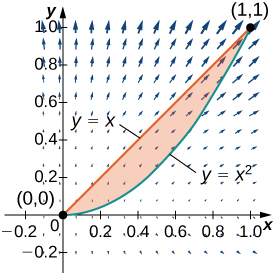
10. Evaluate ∮Cy3dx−x3y2dy, where C is the positively oriented circle of radius 2 centered at the origin.
- Answer
- ∮Cy3dx−x3y2dy=−20π units of work
11. Evaluate ∮Cy3dx−x3dy, where C includes the two circles of radius 2 and radius 1 centered at the origin, both with positive orientation.
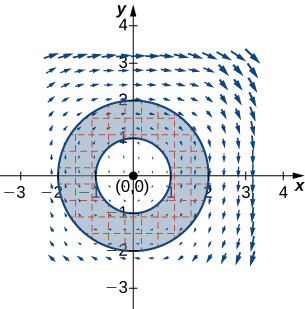
12. Calculate ∮C−x2ydx+xy2dy, where C is a circle of radius 2 centered at the origin and oriented in the counterclockwise direction.
- Answer
- ∮C−x2ydx+xy2dy=8π units of work
13. Calculate integral ∮C2[y+xsin(y)]dx+[x2cos(y)−3y2]dy along triangle C with vertices (0,0),(1,0) and (1,1), oriented counterclockwise, using Green’s theorem.
14. Evaluate integral ∮C(x2+y2)dx+2xydy, where C is the curve that follows parabola y=x2 from (0,0),(2,4), then the line from (2,4) to (2,0), and finally the line from (2,0) to (0,0).
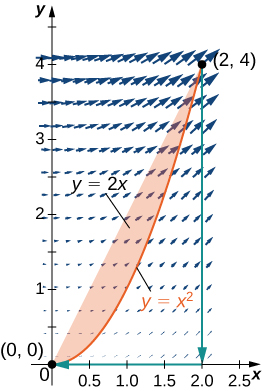
- Answer
- ∮C(x2+y2)dx+2xydy=0 units of work
15. Evaluate line integral ∮C(y−sin(y)cos(y))dx+2xsin2(y)dy, where C is oriented in a counterclockwise path around the region bounded by x=−1,x=2,y=4−x2, and y=x−2.
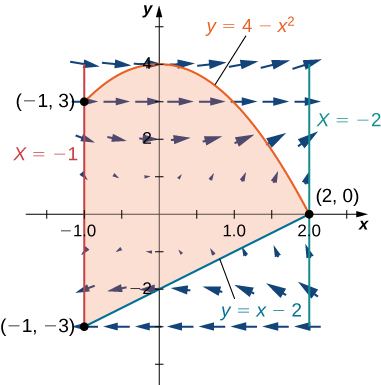
For the following exercises, use Green’s theorem to find the area.
16. Find the area between ellipse x29+y24=1 and circle x2+y2=25.
- Answer
- A=19πunits2
17. Find the area of the region enclosed by parametric equation
⇀p(θ)=(cos(θ)−cos2(θ))ˆi+(sin(θ)−cos(θ)sin(θ))ˆj for 0≤θ≤2π.
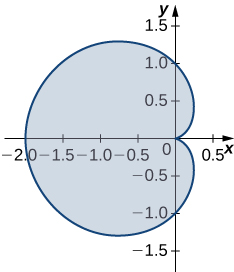
18. Find the area of the region bounded by hypocycloid ⇀r(t)=cos3(t)ˆi+sin3(t)ˆj. The curve is parameterized by t∈[0,2π].
- Answer
- A=38πunits2
19. Find the area of a pentagon with vertices (0,4),(4,1),(3,0),(−1,−1), and (−2,2).
20. Use Green’s theorem to evaluate ∫C+(y2+x3)dx+x4dy, where C+ is the perimeter of square [0,1]×[0,1] oriented counterclockwise.
- Answer
- ∫C+(y2+x3)dx+x4dy=0
21. Use Green’s theorem to prove the area of a disk with radius a is A=πa2units2.
22. Use Green’s theorem to find the area of one loop of a four-leaf rose r=3sin2θ. (Hint: xdy−ydx=r2dθ).
- Answer
- A=9π8units2
23. Use Green’s theorem to find the area under one arch of the cycloid given by the parametric equations: x=t−sint,y=1−cost,t≥0.
24. Use Green’s theorem to find the area of the region enclosed by curve
⇀r(t)=t2ˆi+(t33−t)ˆj, for −√3≤t≤√3.

- Answer
- A=8√35units2
25. [T] Evaluate Green’s theorem using a computer algebra system to evaluate the integral ∫Cxeydx+exdy, where C is the circle given by x2+y2=4 and is oriented in the counterclockwise direction.
26. Evaluate ∫C(x2y−2xy+y2)ds, where C is the boundary of the unit square 0≤x≤1,0≤y≤1, traversed counterclockwise.
- Answer
- ∫C(x2y−2xy+y2)ds=3
27. Evaluate ∫C−(y+2)dx+(x−1)dy(x−1)2+(y+2)2, where C is any simple closed curve with an interior that does not contain point (1,−2) traversed counterclockwise.
28. Evaluate ∫Cxdx+ydyx2+y2, where C is any piecewise, smooth simple closed curve enclosing the origin, traversed counterclockwise.
- Answer
- ∫Cxdx+ydyx2+y2=2π
For the following exercises, use Green’s theorem to calculate the work done by force ⇀F on a particle that is moving counterclockwise around closed path C.
29. ⇀F(x,y)=xyˆi+(x+y)ˆj,C:x2+y2=4
30. ⇀F(x,y)=(x3/2−3y)ˆi+(6x+5√y)ˆj,C: boundary of a triangle with vertices (0,0),(5,0), and (0,5)
- Answer
- W=2252 units of work
31. Evaluate ∫C(2x3−y3)dx+(x3+y3)dy, where C is a unit circle oriented in the counterclockwise direction.
32. A particle starts at point (−2,0), moves along the x-axis to (2,0), and then travels along semicircle y=√4−x2 to the starting point. Use Green’s theorem to find the work done on this particle by force field ⇀F(x,y)=xˆi+(x3+3xy2)ˆj.
- Answer
- W=12π units of work
33. David and Sandra are skating on a frictionless pond in the wind. David skates on the inside, going along a circle of radius 2 in a counterclockwise direction. Sandra skates once around a circle of radius 3, also in the counterclockwise direction. Suppose the force of the wind at point (x,y) is ⇀F(x,y)=(x2y+10y)ˆi+(x3+2xy2)ˆj. Use Green’s theorem to determine who does more work.
34. Use Green’s theorem to find the work done by force field ⇀F(x,y)=(3y−4x)ˆi+(4x−y)ˆj when an object moves once counterclockwise around ellipse 4x2+y2=4.
- Answer
- W=2π units of work
35. Use Green’s theorem to evaluate line integral ∮Ce2xsin2ydx+e2xcos2ydy, where C is ellipse 9(x−1)2+4(y−3)2=36 oriented counterclockwise.
36. Evaluate line integral ∮Cy2dx+x2dy, where C is the boundary of a triangle with vertices (0,0),(1,1), and (1,0), with the counterclockwise orientation.
- Answer
- ∮Cy2dx+x2dy=13 units of work
37. Use Green’s theorem to evaluate line integral ∫C⇀h·d⇀r if ⇀h(x,y)=eyˆi−sinπxˆj, where C is a triangle with vertices (1,0),(0,1), and (−1,0), traversed counterclockwise.
38. Use Green’s theorem to evaluate line integral ∫C√1+x3dx+2xydy where C is a triangle with vertices (0,0),(1,0), and (1,3) oriented clockwise.
- Answer
- ∫C√1+x3dx+2xydy=3 units of work
39. Use Green’s theorem to evaluate line integral ∫Cx2ydx−xy2dy where C is a circle x2+y2=4 oriented counterclockwise.
40. Use Green’s theorem to evaluate line integral ∫C(3y−esinx)dx+(7x+√y4+1)dy where C is circle x2+y2=9 oriented in the counterclockwise direction.
- Answer
- ∫C(3y−esinx)dx+(7x+√y4+1)dy=36π units of work
41. Use Green’s theorem to evaluate line integral ∫C(3x−5y)dx+(x−6y)dy, where C is ellipse x24+y2=1 and is oriented in the counterclockwise direction.
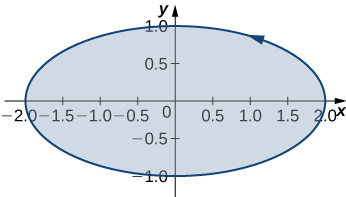
42. Let C be a triangular closed curve from (0,0) to (1,0) to (1,1) and finally back to (0,0). Let ⇀F(x,y)=4yˆi+6x2ˆj. Use Green’s theorem to evaluate ∮C⇀F·d⇀r.
- Answer
- ∮C⇀F·d⇀r=2 units of work
43. Use Green’s theorem to evaluate line integral ∮Cydx−xdy, where C is circle x2+y2=a2 oriented in the clockwise direction.
44. Use Green’s theorem to evaluate line integral ∮C(y+x)dx+(x+siny)dy, where C is any smooth simple closed curve joining the origin to itself oriented in the counterclockwise direction.
- Answer
- ∮C(y+x)dx+(x+siny)dy=0 units of work
45. Use Green’s theorem to evaluate line integral ∮C(y−ln(x2+y2))dx+(2arctanyx)dy, where C is the positively oriented circle (x−2)2+(y−3)2=1.
46. Use Green’s theorem to evaluate ∮Cxydx+x3y3dy, where C is a triangle with vertices (0,0),(1,0), and (1,2) with positive orientation.
- Answer
- ∮Cxydx+x3y3dy=2221 units of work
47. Use Green’s theorem to evaluate line integral ∫Csinydx+xcosydy, where C is ellipse x2+xy+y2=1 oriented in the counterclockwise direction.
48. Let ⇀F(x,y)=(cos(x5)−13y3)ˆi+13x3ˆj. Find the counterclockwise circulation ∮C⇀F·d⇀r, where C is a curve consisting of the line segment joining (−2,0) and (−1,0), half circle y=√1−x2, the line segment joining (1,0) and (2,0), and half circle y=√4−x2.
- Answer
- ∮C⇀F·d⇀r=15π4 units of work
49. Use Green’s theorem to evaluate line integral ∫Csin(x3)dx+2yex2dy, where C is a triangular closed curve that connects the points (0,0),(2,2), and (0,2) counterclockwise.
50. Let C be the boundary of square 0≤x≤π,0≤y≤π, traversed counterclockwise. Use Green’s theorem to find ∫Csin(x+y)dx+cos(x+y)dy.
- Answer
- ∫Csin(x+y)dx+cos(x+y)dy=4 units of work
51. Use Green’s theorem to evaluate line integral ∫C⇀F·d⇀r, where ⇀F(x,y)=(y2−x2)ˆi+(x2+y2)ˆj, and C is a triangle bounded by y=0,x=3, and y=x, oriented counterclockwise.
52. Use Green’s Theorem to evaluate integral ∫C⇀F·d⇀r, where ⇀F(x,y)=(xy2)ˆi+xˆj, and C is a unit circle oriented in the counterclockwise direction.
- Answer
- ∫C⇀F·d⇀r=π units of work
53. Use Green’s theorem in a plane to evaluate line integral ∮C(xy+y2)dx+x2dy, where C is a closed curve of a region bounded by y=x and y=x2 oriented in the counterclockwise direction.
54. Calculate the outward flux of ⇀F(x,y)=−xˆi+2yˆj over a square with corners (±1,±1), where the unit normal is outward pointing and oriented in the counterclockwise direction.
- Answer
- ∮C⇀F·⇀Nds=4
55. [T] Let C be circle x2+y2=4 oriented in the counterclockwise direction. Evaluate ∮C[(3y−earctanx)dx+(7x+√y4+1)dy] using a computer algebra system.
56. Find the flux of field ⇀F(x,y)=−xˆi+yˆj across x2+y2=16 oriented in the counterclockwise direction.
- Answer
- ∮C⇀F·⇀Nds=32π
57. Let ⇀F=(y2−x2)ˆi+(x2+y2)ˆj, and let C be a triangle bounded by y=0,x=3, and y=x oriented in the counterclockwise direction. Find the outward flux of ⇀F through C.
58. [T] Let C be unit circle x2+y2=1 traversed once counterclockwise. Evaluate ∫C[−y3+sin(xy)+xycos(xy)]dx+[x3+x2cos(xy)]dy by using a computer algebra system.
- Answer
- ∫C[−y3+sin(xy)+xycos(xy)]dx+[x3+x2cos(xy)]dy=4.7124 units of work
59. [T] Find the outward flux of vector field ⇀F(x,y)=xy2ˆi+x2yˆj across the boundary of annulus R={(x,y):1≤x2+y2≤4}={(r,θ):1≤r≤2,0≤θ≤2π} using a computer algebra system.
60. Consider region R bounded by parabolas y=x2 and x=y2. Let C be the boundary of R oriented counterclockwise. Use Green’s theorem to evaluate ∮C(y+e√x)dx+(2x+cos(y2))dy.
- Answer
- ∮C(y+e√x)dx+(2x+cos(y2))dy=13 units of work
Contributors
Gilbert Strang (MIT) and Edwin “Jed” Herman (Harvey Mudd) with many contributing authors. This content by OpenStax is licensed with a CC-BY-SA-NC 4.0 license. Download for free at http://cnx.org.


